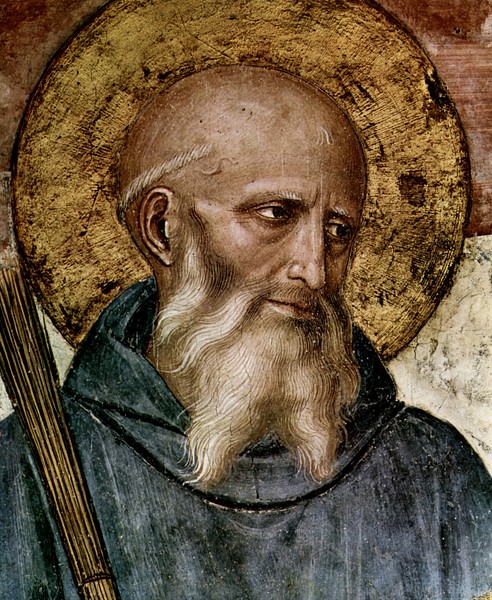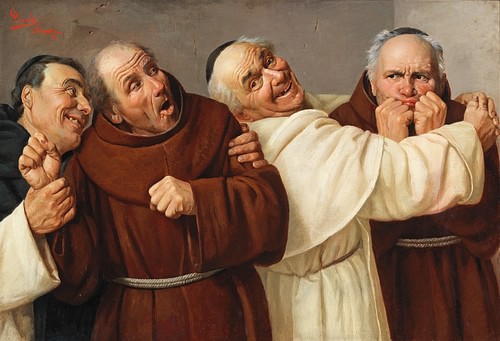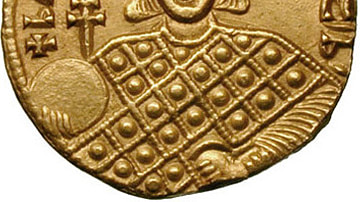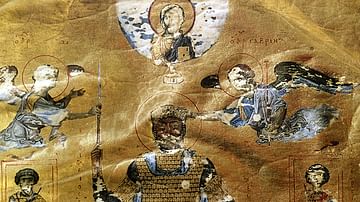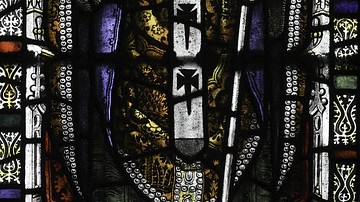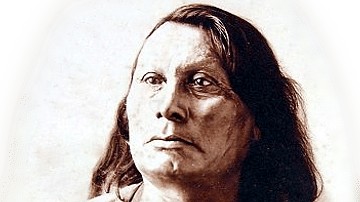
A medieval monastery was an enclosed and sometimes remote community of monks led by an abbot who shunned worldly goods to live a simple life of prayer and devotion. Christian monasteries first developed in the 4th century in Egypt and Syria and by the 5th century the idea had spread to Western Europe.
Such figures as Saint Benedict of Nursia (d. c. 543), the founder of the Benedictine order, established rules by which the monks should live and these were, to various degrees, imitated and followed in subsequent centuries, including in those monasteries which survive today. Although their members were poor, the monasteries themselves were rich and powerful institutions, gathering wealth from land and property donated to them. Monasteries were also important centres of learning which educated the young, and, perhaps most significantly for today's historians, laboriously produced books and preserved ancient texts which have greatly enhanced our knowledge of not only the medieval world but also classical antiquity.
Origins & Development
From the 3rd century CE there developed a trend in Egypt and Syria which saw some Christians decide to live the life of a solitary hermit or ascetic. They did this because they thought that without any material or worldly distractions they would achieve a greater understanding of and closeness to God. In addition, whenever early Christians were persecuted they were sometimes forced by necessity to live in remote mountain areas where the essentials of life were lacking. As these individualists grew in number some of them began to live together in communities, continuing, though, to cut themselves off from the rest of society and devoting themselves entirely to prayer and the study of scriptures. Initially, members of these communities lived together in a place known as a lavra where they continued their solitary lives and only gathered together for religious services. Their leader, an abba (hence the later 'abbot') presided over these individualists – they were called monachos in Greek for that reason, which derived from mono meaning 'one', and which is the origin of the word 'monk'.
One of the earliest ascetics to begin organising monasteries where monks lived more communally was Pachomios (c. 290-346), an Egyptian and former soldier who, perhaps inspired by the efficiency of Roman army camps, founded nine monasteries for men and two for women at Tabennisi in Egypt. These first communal (cenobitic) monasteries were administered following a list of rules compiled by Pachomios, and this style of communal living (koinobion), where monks lived, worked, and worshipped together in a daily routine, with all property held in common, and an abbot administering them, became the common model in the Byzantine period.
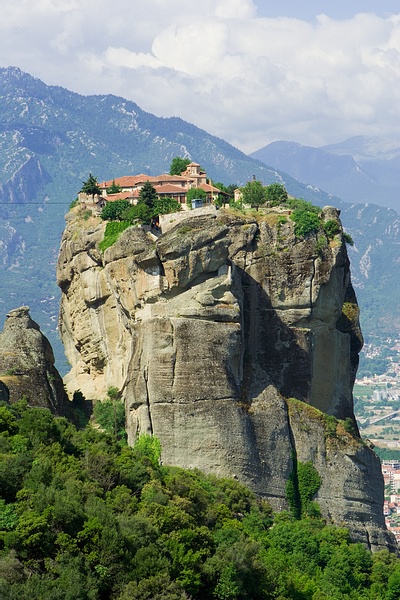
The next step on the road to the type of monastery that became standard during the Middle Ages was made by Basil of Caesarea (aka Saint Basil or Basil the Great, c. 330-c. 379) in the 4th century. Basil had seen for himself the monasteries in Egypt and Syria and he sought to reproduce them across the Eastern Roman/Byzantine Empire. Basil added an extra dimension with his belief that monks should not only work together for common goals but also contribute to the wider community. Byzantine monasteries were independent organisations with their own set of rules and regulations for brother monks.
The Benedictine Order
From the 5th century CE the idea of monasteries spread across the Byzantine Empire and then to Western Europe where they adopted their own distinct practices based on the teachings of the Italian abbot Saint Benedict of Nursia (c. 480-c. 543), regarded as the founder of the European monastery model. Benedict himself founded a monastery at Monte Cassino in Italy. The Benedictine order encouraged its members to live as simple a life as possible with simple food, basic accommodation and as few possessions as was practical. The monks were expected to live together in a shared community of mutual aid and watchfulness, participating in the physical labour needed to make the monastery economically self-sufficient as well as undertake religious studies and prayer. There was a set of regulations – collectively known as the monastic Rule (regula) – that monks had to follow, although their severity and practical application was largely down to the individual abbots who ruled with absolute authority in each monastery. Women too could live the monastic life as nuns in abbeys and nunneries.
Greatly helped by tax relief and donations, monasteries grew in sophistication and wealth, so as the Middle Ages wore on physical labour became less of a necessity for monks because they could now rely on the efforts of lay brothers, hired labourers of serfs (unfree labourers). Consequently, monks in the High Middle Ages were able to spend more time on scholarly pursuits, particularly in producing such medieval monastic specialties as illuminated manuscripts.
The Cistercian Order
From the 11th century new orders began to appear, most notably the Cistercian order (formed in 1098), largely because some monks wanted an even stricter lifestyle for themselves than the Benedictines could offer. The Cistercian order put much more emphasis on religious studies and minimised the physical labour monks were expected to perform. Such labour as working the monastery's agricultural lands or baking bread was done, instead, by hired labour or lay brothers who were not full monks. In keeping with their more severe lifestyle, Cistercian monasteries were also located in more remote locations than Benedictine ones and had plain buildings with a minimum of carved stonework, interior decorations, and even comforts.
From the 13th century, there developed another branch of the ascetic life consisting of friars who rejected all material goods and lived not in monastic communities but as individuals entirely dependent on the handouts of well-wishers. Saint Francis of Assisi (c. 1181-1260) famously established a mendicant (begging) order, the Franciscans, which was then imitated by the Dominicans (c. 1220) and subsequently by the Carmelites (late 12th century) and Augustinians (1244).
Daily Life
Monasteries varied greatly in size with the smaller ones having only a dozen or so monks and perhaps being led by a prior instead of an abbot. Larger ones such as Cluny Abbey in France (founded c. 910), boasted 460 monks at its peak in the 12th century but around 100 brothers seems to have been a typical number for most monasteries. The abbot was selected by the senior monks and had the job for life. He was assisted by a prior and those monks that were given specific administrative duties, the obedientiaries, who looked after various aspects of the monastery such as the church, religious services, the library, income from estates, the food stores or the wine cellar. The abbot represented the monastery in the outside world, for instance at gatherings of the order or at meetings concerned with the management of the monastery's estates.
Ordinary monks lived simple lives, of course. With monks usually not being permitted to leave the monastery, their day was spent on agricultural tasks and religious studies which included reading set texts, copying books to create new illuminated manuscripts, teaching oblates (young males) or novices (trainee monks), and saying prayers (which was officially classified as 'work' or rather 'God's work'). The day, and even the night, was regularly punctuated by religious services and the morning chapter meeting when all the monks met to discuss the affairs of the monastery. Expected to go about their business mostly in silence, wear simple rough clothing and forgo all but the most basic items of personal property, the monks' one perk was decent food and drink throughout the year, taken in one main meal each day (or two in winter).
The Monastery's Buildings
Monasteries varied in size and so their need for certain buildings differed. Indeed, sometimes geography dictated architecture such as with the remote mountain-top monasteries at Meteora in Greece or the Benedictine abbey on the tidal islet of Mont-Saint-Michel in France. However, many did share essential architectural features and the ground plans at the heart of a European monastery were remarkably consistent throughout the Middle Ages. Monasteries often had high encircling walls but whether these were primarily aimed at keeping ordinary people out or the monks in is a moot point. Access from outside was through the main gate.
The heart of the monastery was the cloister: an arcade around an open square space. Access to the cloister was usually restricted and nobody outside the monastic community was permitted to enter it without permission. The cloister was one of the few areas the monks could talk freely and here the novices were taught and chores were done such as sharpening one's knife on the monastery's whetstone or washing clothing in large stone basins.
Adjoining the cloister was the church with a belfry tower, important for calling the monks to service. There were storehouses, extensive cellars for food and wine storage, and perhaps stables, too. There was a chapter house for the daily general meeting, a library and, facing south for the best light, a scriptorium where the books were made by the monks. Communal meals were taken in the refectory with its long wooden dining tables. Adjoining the refectory were kitchens, a bakery and a garden where vegetables and herbs were grown and fish were kept in a pond. Also next to the refectory was the calefectory, the only heated room in the monastery (besides the kitchens), where monks could go and warm themselves up for a short while in winter. There were separate dormitories for the monks, the oblates, and the novices.
Beyond the cloister were ancillary buildings which depended on the size of the monastery. There might be an infirmary for the aged and sick with its own kitchens. The lay brothers lived in their own accommodation block, typically in an outer courtyard, which usually had its own kitchen as there food could be prepared that the monks were not allowed to eat. There might be an additional accommodation building for travellers and workshops where certain skilled workers such as tailors, goldsmiths or glazers worked. There could also be a cemetery for the monks only and another one for important lay locals.
The sanitation of a fair-sized monastery was amongst the best to be found anywhere in the medieval world. Cluny had a latrine block with an impressive 45 cubicles which emptied into a drainage channel through which ran water diverted from a nearby stream. There might also be a bathhouse in the larger monasteries, even if frequent bathing was frowned upon as an unnecessary luxury for monks.
Monasterial Power
A large monastery was much like a medieval castle or manor house in that it controlled a surrounding area of land and essentially contained all the elements one would find in a small village of the period. In the manorial system of Europe, land was typically parcelled out into areas known as manors – the smallest estate which had a few hundred acres and so was capable of providing an income to a lord and his family. A monastery acquired manors through donations and so could end up managing many disparate estates with their income all flowing into the monastery's coffers. Other donations might include properties in towns or even churches and so more cash came from rents and tithes. The rich made such donations to increase their local prestige; it is not coincidental that in England and Wales, for example, 167 castles and monasteries were built next to each other between the 11th-15th century. In addition, by helping to establish a monastery a lord could benefit materially from its produce and could perhaps safeguard his soul in the next life, both through the action of his donation and the quota of prayers said in his name as a result of it. Added to their income from donations, land rents and the sale of goods produced from such land, many monasteries raked in money from holding markets and producing craft-goods, while some even had the right to mint their own coinage
Monasteries, as institutions full of educators and scholars, also proved useful tools to the state. Monarchs frequently used monks, with their skills in Latin and document-making, in their royal writing offices or a monastery itself performed that function. We know, for example, that Winchombe monastery in Gloucestershire, England and the abbey of Saint-Wandrille near Rouen in France, were used as a royal archive in the 9th century for their respective kingdoms. In addition, large monasteries educated the aristocracy and often had specialised teaching facilities such as at Whitby Abbey in North-East England, which educated a long line of bishops and counted Saint John of Beverley (d. 721) amongst its alumni.
Community Role & Legacy
A monastery provided local communities with spiritual guidance; very often its church was for wider public use, it gave employment, and its monks provided education, safe-guarded holy relics, entertained the pilgrims who came to visit, looked after orphans, the sick and aged, and daily gave out food, drink and alms to the poor. Monks produced and copied countless invaluable historical documents such as religious treatises, biographies of saints and regional histories. Their illuminated manuscripts have gained global renown and include such surviving masterpieces as the Book of Kells and the Lindisfarne Gospels.
Monasteries sponsored the arts, especially the production of frescoes and mosaics both inside the monastery and the wider world in order to spread the Christian message. Monasteries were vital (if not always successful) protectors of art and historical documents, too, especially in times of turmoil such as warfare, Viking raids or heresies like iconoclasm in the 8th and 9th centuries CE when religious art was ruthlessly destroyed and seen as blasphemous. Due to these efforts, we can today read texts not only from medieval times but also antiquity thanks to the labour of copyist monks and the monasteries which preserved those texts.
Monasteries were such thriving and stable communities that many of them acquired a periphery of domestic and functional buildings where people permanently lived and worked to provide the monks with what they required. Consequently, many towns today are situated where they are because a monastery was once located there. Finally, there are many still-functioning medieval monasteries such as the ones at Meteora or Mount Athos in Greece, which are themselves a living connection with the past and which continue to provide assistance to society's most needy.
